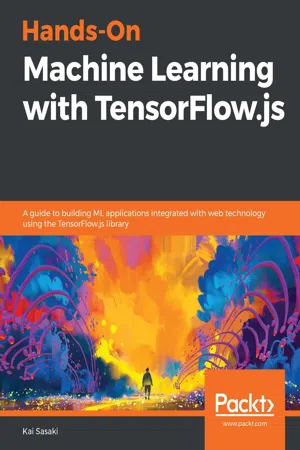
Hands-On Machine Learning with TensorFlow.js
A guide to building ML applications integrated with web technology using the TensorFlow.js library
Kai Sasaki
- 296 Seiten
- English
- ePUB (handyfreundlich)
- Über iOS und Android verfügbar
Hands-On Machine Learning with TensorFlow.js
A guide to building ML applications integrated with web technology using the TensorFlow.js library
Kai Sasaki
Über dieses Buch
Get hands-on with the browser-based JavaScript library for training and deploying machine learning models effectively
Key Features
- Build, train and run machine learning models in the browser using TensorFlow.js
- Create smart web applications from scratch with the help of useful examples
- Use flexible and intuitive APIs from TensorFlow.js to understand how machine learning algorithms function
Book Description
TensorFlow.js is a framework that enables you to create performant machine learning (ML) applications that run smoothly in a web browser. With this book, you will learn how to use TensorFlow.js to implement various ML models through an example-based approach.
Starting with the basics, you'll understand how ML models can be built on the web. Moving on, you will get to grips with the TensorFlow.js ecosystem to develop applications more efficiently. The book will then guide you through implementing ML techniques and algorithms such as regression, clustering, fast Fourier transform (FFT), and dimensionality reduction. You will later cover the Bellman equation to solve Markov decision process (MDP) problems and understand how it is related to reinforcement learning. Finally, you will explore techniques for deploying ML-based web applications and training models with TensorFlow Core. Throughout this ML book, you'll discover useful tips and tricks that will build on your knowledge.
By the end of this book, you will be equipped with the skills you need to create your own web-based ML applications and fine-tune models to achieve high performance.
What you will learn
- Use the t-SNE algorithm in TensorFlow.js to reduce dimensions in an input dataset
- Deploy tfjs-converter to convert Keras models and load them into TensorFlow.js
- Apply the Bellman equation to solve MDP problems
- Use the k-means algorithm in TensorFlow.js to visualize prediction results
- Create tf.js packages with Parcel, Webpack, and Rollup to deploy web apps
- Implement tf.js backend frameworks to tune and accelerate app performance
Who this book is for
This book is for web developers who want to learn how to integrate machine learning techniques with web-based applications from scratch. This book will also appeal to data scientists, machine learning practitioners, and deep learning enthusiasts who are looking to perform accelerated, browser-based machine learning on Web using TensorFlow.js. Working knowledge of JavaScript programming language is all you need to get started.
Häufig gestellte Fragen
Information
Section 1: The Rationale of Machine Learning and the Usage of TensorFlow.js
- Chapter 1, Machine Learning for the Web
- Chapter 2, Importing Pretrained Models into TensorFlow.js
- Chapter 3, TensorFlow.js Ecosystem
Machine Learning for the Web
- Web-based programming languages, such as JavaScript and TypeScript
- Web platform technology stacks (only a basic knowledge is required)
- The fundamentals of machine learning algorithms
- Why machine learning on the web?
- Operation graphs
- What is TensorFlow.js?
- Installing TensorFlow.js
- The low-level API
- The Layers API
Technical requirements
- A web browser (Chrome is recommended): TensorFlow.js primarily runs on web browsers.
- The Node.js environment, which contains a node package manager (npm): Node.js is necessary since it resolves dependencies so that we can run TensorFlow.js.
- TypeScript compiler: TensorFlow.js and its application are often written in TypeScript.
- Python (3.x is recommended): We need this so that we can run Python-dependent tools such as tfjs-converter and the TensorFlow Python API.
Why machine learning on the web?
Operation graphs
Inhaltsverzeichnis
- Title Page
- Copyright and Credits
- About Packt
- Contributors
- Preface
- Section 1: The Rationale of Machine Learning and the Usage of TensorFlow.js
- Machine Learning for the Web
- Importing Pretrained Models into TensorFlow.js
- TensorFlow.js Ecosystem
- Section 2: Real-World Applications of TensorFlow.js
- Polynomial Regression
- Classification with Logistic Regression
- Unsupervised Learning
- Sequential Data Analysis
- Dimensionality Reduction
- Solving the Markov Decision Process
- Section 3: Productionizing Machine Learning Applications with TensorFlow.js
- Deploying Machine Learning Applications
- Tuning Applications to Achieve High Performance
- Future Work Around TensorFlow.js
- Other Books You May Enjoy